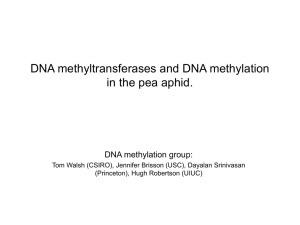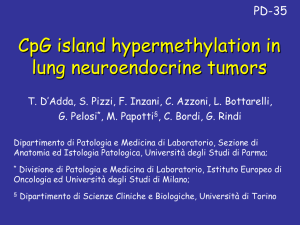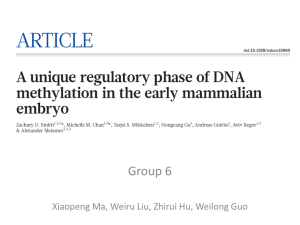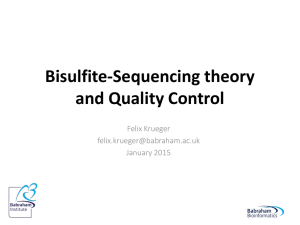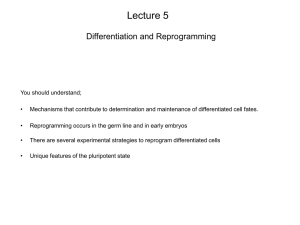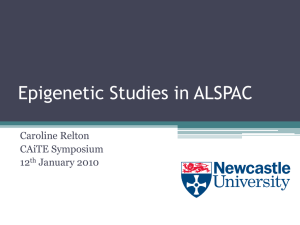Presentation Sabine Zöchbauer-Müller
advertisement
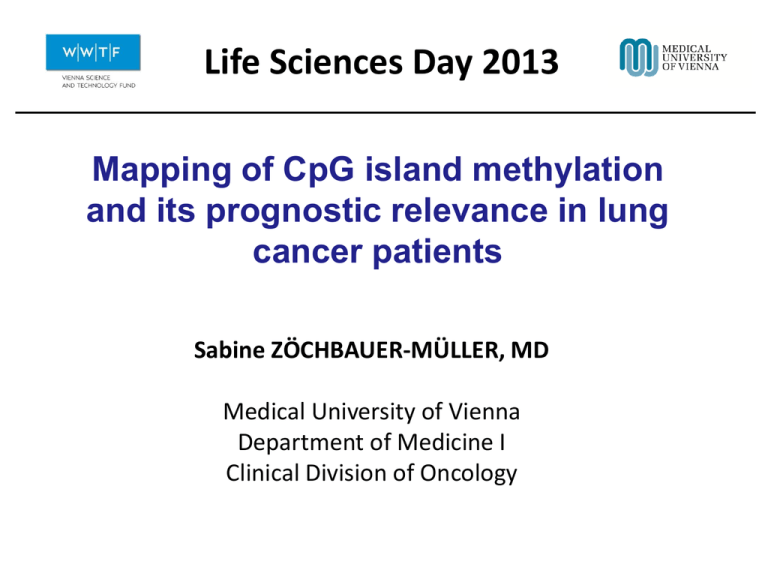
Life Sciences Day 2013 Mapping of CpG island methylation and its prognostic relevance in lung cancer patients Sabine ZÖCHBAUER-MÜLLER, MD Medical University of Vienna Department of Medicine I Clinical Division of Oncology OVERVIEW • Background of DNA methylation • Mapping of CpG island (CGI) methylation and its prognostic relevance in lung cancer patients • Genome-wide microRNA (miRNA) expression profiling identifies targets for DNA methylation in non-small cell lung cancers • Human ressources development • Publications • Research grants • Outlook • Acknowledgement EPIGENETIC MECHANISMS CONTRIBUTE TO TRANSCRIPTIONAL GENE SILENCING DNA methylation ….. • epigenetic change occurring at CG dinucleotides within CGI located in 5` region of many cancer-related genes • affects together with other epigenetic changes binding of transcription factors to DNA leading to gene silencing • frequently occuring change in neoplastic cells • reversibel by demethylating drugs DNA METHYLATION IN LUNG CANCER • Lung cancer leading cause of cancer deaths worldwide with patient`s 5-year overall survival rates of ~ 14% • Many protein-encoding genes identified to be frequently methylated in non-small cell lung cancers (NSCLC) • So far mainly analyses of single genes or small numbers of genes • Methylation of certain protein-encoding genes of potential clinical relevance in NSCLC patients • Mechanism for deregulation of microRNA expression in NSCLC? MAPPING OF CGI METHYLATION AND ITS PROGNOSTIC RELEVANCE IN LUNG CANCER PATIENTS Aims … • Genome-wide search for methylated CGIs in tumor (TU) and corresponding non-malignant lung tissue samples (NL) from a large number of NSCLC patients • Identification of tumor-specifically methylated genes • Confirmation of methylation by gene-specific analyses • Comparison of methylation with expression patterns • Investigation of effects of epigenetically active drugs on gene expression • Investigation of potential tumor suppressor gene function • Determination of potential clinical relevance of methylated genes in NSCLC patients Heller et al, Carcinogenesis 2013 METHODS • Methylated DNA immunoprecipitation and microarray analysis using NimbleGen`s 385K Human CGI plus Promoter array (MeDIP-chip) including statistical analyses of primary TU and corresponding NL tissue samples of 101 stage I-IIIA NSCLC patients • Functional characterization using Ontologizer • Gene-specific methylation analyses using methylation-sensitive high resolution melting (MS-HRM) approach • Bisulfite genomic sequencing (BGS) • Microarray expression analyses of untreated/drug treated NSCLC cells • Immunohistochemistry (IHC) • Overexpression of genes in NSCLC cells followed by cell viability/proliferation assays • Comparison of methylation results with clinico-pathological characteristics of patients Heller et al, Carcinogenesis 2013 CHROMOSOMAL DISTRIBUTION OF PROBES FOUND TO BE DIFFERENTIALLY METHYLATED • Identification of 2.414 probes differentially methylated between TU and corresponding NL samples • 97% of probes tumor-specifically methylated (dots above upper red line) • Tumor-specifically methylated probes at all chromosomes except chromosome 22 and Y chromosome • 3% of probes methylated at higher extent in NL samples (dots below lower red line) X-axis, probe position; y-axis, t-statistics; upper and lower red lines indicate significance levels (adjusted p-values for step-down multiple testing < 0.05) Heller et al, Carcinogenesis 2013 FROM PROBES TO GENES • Annotation and dereplication of differentially methylated probes • Identification of 477 unique tumor-specifically methylated genes • 406 characterized protein encoding genes, 38 predicted genes, 33 non-coding RNA encoding genes • Association of 95% of protein encoding genes with a 5`CGI • Several tumor-specifically methylated genes located in gene clusters: HOXA, HOXB, HOXD, PCDHA, PCDHGA, PCDHGB • 149 tumor-specifically methylated genes involved in transcriptional gene expression and 61 in cell adhesion • From majority of genes methylation in NSCLCs unknown Heller et al, Carcinogenesis 2013 COMPARISON OF PERCENT OF METHYLATION IN TU AND NL SAMPLES BY MS-HRM ANALYSES y-axis: % of methylation; each line represents an individual patient; * P ≤ 0.05; ** P ≤ 0.01; ***P ≤ 0.001 Heller et al, Carcinogenesis 2013 TUMOR-SPECIFIC METHYLATION BY BGS 3 clones of TU and corresponding NL sequenced; relatively homogeneous methylation in TU; no or low methylation in corresponding NL; Heller et al, Carcinogenesis 2013 EFFECT OF EPIGENETICALLY ACTIVE DRUGS ON EXPRESSION OF TUMOR-SPECIFICALLY METHYLATED GENES • Microarray expression analyses of untreated and with Aza-dC or Aza-dC/TSA treated NSCLC cells • Upregulation of expression of 31% of tumor-specifically methylated genes* after drug treatment in NSCLC cell lines (fold change ≥ 1.5, FDR ≤ 0.1); *identified by MeDIP- chip analyses of NSCLC cell lines A549, NCI-H1993 and NCI-H2073 Heller et al, Carcinogenesis 2013 IHC STAINING OF TU AND NL SAMPLES Lack of expression in cancer cells Lack of expression in cancer cells Lack of expression in cancer cells Weak expression in cancer cells Nuclear expression in normal bronchiolar epithelial cells Cytoplasmic expression in normal bronchiolar epithelial cells Cytoplasmic expression in alveolar epithelial cells and macrophages Stronger cytoplasmic expression in normal bronchiolar epithelial cells and leucocytes TU samples methylated for individual gene; Heller et al, Carcinogenesis 2013 REDUCED CELL VIABILITY/CELL PROLIFERATION AFTER L1TD1 OVEREXPRESSION IN L1TD1 METHYLATED NSCLC CELLS Tumor-specific L1TD1 methylation determined by MS-HRM analysis Up-regulated L1TD1 expression after Aza-dC treatment Cell viability normalized to GFP control Cell proliferation determined in real-time Heller et al, in preparation REDUCED CELL VIABILITY/CELL PROLIFERATION AFTER ZNF677 OVEREXPRESSION IN ZNF677 METHYLATED NSCLC CELLS Empty ZNF677 NCSLC cells transfected with empty control vector or ZNF677 expression vector Cell viability normalized to GFP control Cell proliferation determined in real-time Heller et al, in preparation STATISTICALLY SIGNIFICANT SURVIVAL DIFFERENCES* REGARDING METHYLATION Cumulative survival Methylation of Shorter DFS Shorter OS HOXA2§ HOXA2 HOXA10§ HOXA2 and/or HOXA10§ HOXA2 and/or HOXA10 ZNF677§ * Univariate analysis; § Independent prognostic parameters by multivariate analysis; HOXA2, HOXA10, HOXA2/HOXA10 : SCC patients; ZNF677: NSCLC patients; P = 0.013 Months Kaplan-Meier plot of OS according to ZNF677 methylation. Heller et al, Carcinogenesis 2013 Heller et al, in preparation CONCLUSION • Identification of large number of tumor-specifically methylated genes in NSCLC patients • From many of them methylation in NSCLCs unknown so far • Involvement of about half of genes in regulation of gene expression or cell adhesion • Association of methylation of many genes with transcriptional regulation • Putative tumor suppressor gene function of L1TD1 and ZNF677 • Identification of HOXA2, HOXA10 and ZNF677 as potential prognostic markers • Findings emphasize impact of methylation on pathogenesis of NSCLCs Heller et al, Carcinogenesis 2013 Heller et al, in preparation Heller et al, in preparation GENOME-WIDE miRNA EXPRESSION PROFILING IDENTIFIES TARGETS FOR DNA METHYLATION IN NON-SMALL CELL LUNG CANCER Aims … • Investigation of potential role of DNA methylation on miRNA silencing in NSCLCs • Investigation of miRNA methylation in TU and corresponding NL samples of NSCLC patients • Determination of potential clinical relevance of miRNA methylation in NSCLC patients Heller et al, Clin Cancer Res 2012 METHODS • Determination of genome-wide miRNA expression of untreated and with epigentically activs drugs treated A549 cells by microarray analyses • miRNA target prediction and functional annotation • Gene-specific methylation analyses using MS-HRM approach in NSCLC cell lines, primary TU and corresponding NL tissue samples from 101 stage I-IIIA NSCLC patients • BGS • Comparison of methylation with gene expression patterns • Comparison of methylation results with clinico-pathological characteristics of patients Heller et al, Clin Cancer Res 2012 MICROARRAY EXPRESSION ANALYSIS OF 856 miRNAs IN A549 CELLS •Upregulation of expression of 66 miRNAs after drug treatment (fold change ≥ 1.5; P < 0.1) •Association of 33 miRNAs with CGI e.g. miR-7, miR-9-3, miR-29c, miR-34a, miR125a, miR-193a, miR-200c, miR-375 GO analysis of predicted targets of 33 miRNAs Heller et al, Clin Cancer Res 2012 TUMOR-SPECIFIC METHYLATION OF miR-9-3 AND miR-193a BY MS-HRM IN NSCLC PATIENTS Each circle represents individual sample. Heatmaps show comparison of percentage of methylation between TU and NL samples of each patient. Heller et al, Clin Cancer Res 2012 miR-9-3 METHYLATION AND SURVIVAL OF LUNG SQUAMOUS CELL CARCINOMA PATIENTS Kaplan-Meier plots of disease-free and overall survival according to mi-9-3 methylation. Heller et al, Clin Cancer Res 2012 CONCLUSION • Identification of 66 miRNAs with upregulated expression after drug treatment • Association of 33 miRNAs with a CGI • Identification of tumor-specific miR-9-3 and miR-193a methylation in NSCLC patients • Association of miR-9-3 methylation with shorter DFS and OS of SCC patients • Identification of methylation as mechanism for miRNA silencing in NSCLCs • Findings of potential clinical relevance Heller et al, Clin Cancer Res 2012 HUMAN RESSOURCES DEVELOPMENT • Gerwin Heller*, PhD, post doc: permanent employment contract at the MUV, ready for “Venia docendi“ • Valerie Babinsky*, diploma student: finished thesis • Marlene Weinzierl, diploma student: finished thesis • Christian Noll*, diploma student: finished thesis • Corinna Altenberger*, diploma student: finished thesis, now PhD student • Bianca Schmid, diploma student: thesis in progress • Barbara Ziegler, technician: Nomination as lab manager *Financed by WWTF MAJOR PUBLICATIONS • • • • • • • • • • • • Heller G et al, Anticancer Res 2009 Heller G et al, Cancer Metastasis Rev 2010 Kollmann K et al*, Blood, 2011 Kollmann K et al*, Oncotarget 2011 Heller G et al, Clin Cancer Res 2012 Ghanim V et al*, Blood 2012 Brodowicz T et al*, Ann Oncol 2012 Heller G et al, Carcinogenesis 2013 Kollmann K et al*, Cancer Cell 2013 Preusser M et al*, Lung Cancer 2013 Höbaus J et al*, Int J Cancer 2013 Berghoff AS et al*, APMIS 2013 Peer reviewed journals; * Co-Autorship; IF 2012 IF 1.713 IF 7.787 IF 9.060 IF 6.636 IF 7.837 IF 9.060 IF 4.120 IF 5.635 IF 24.755 IF 3.392 IF 6.198 IF 2.068 IF 88.261 RESEARCH GRANTS • Research grant from the FWF to Zöchbauer-Müller S: DNA methylation mediated microRNA gene silencing in non-small cell lung cancer patients, duration 3 years • Special research program (SFB) grant from the FWF to the SFB consortium (Valent P, Kralovics R, Lion T, Sexl V, Moriggl R, Zöchbauer-Müller S, Zuber J, Superti-Furga G, Mannhalter C, Nijman S): Myeloproliferative neoplasms - pathogenesis and development of new therapeutic strategies; subtheme: Epigenetic mechanisms involved in disease manifestation and progression in MPN, duration 4 years • Research grant from the Austrian Society of Hematology and Oncology to Heller G: Identification of novel epigenetically silenced tumor suppressor genes in NSCLCs, duration 1 year OUTLOOK • Characterization of additional tumor-specifically methylated genes regarding function and potential prognostic relevance in NSCLC patients • Identification of patients with “bad prognosis“ regarding pattern of tumor-specifically methylated genes • Identification of exclusively in NSCLCs tumor-specifically methylated genes • Investigation of methylation from panel of markers in serum samples to diagnose NSCLC • Relevance for more individualized treatment of patients and early detection of NSCLC ? THANK YOU FOR THE WWTF GRANT! Martin Posch, PhD, MUV Leonhard Müllauer, MD, MUV Walter Klepetko, MD, MUV Kwun Fong, MD, Prince Charles Hospital, Brisbane Balasz Döme, MD, PhD, Budapest Balasz Hegedüs, PhD, MUV Veronika Sexl, MD, Vetmeduni Peter Valent, MD, MUV Christoph Bock, PhD, CeMM Martin Bilban, PhD, MUV Christine Mannhalter, MD, MUV
